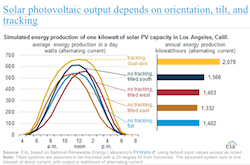A recent Today in Energy published by the Energy Information Administration (EIA), takes a look at the variability of solar energy output. Pointing out that while many companies have improved on the technologies (such as tilt) and know-how of installing solar panels to capture the most sun per day, output peaks around noon when the sun is at its highest. This can be a challenge as peak energy use often climaxes in late afternoon or early evening.
 During this time of day, west-facing PV panels have an advantage over south-facing panels, as they’re tilted towards the setting sun. EIA notes that higher PV output at this time of day is often beneficial to grid operators working to increase electric supply to balance high levels of demand, but customers generally will not see this benefit unless they are on time-of-use electric rates. For example, under net-metering arrangements, the financial benefit of these PV systems is based on the quantity of kilowatthours generated, regardless of the time of day.
During this time of day, west-facing PV panels have an advantage over south-facing panels, as they’re tilted towards the setting sun. EIA notes that higher PV output at this time of day is often beneficial to grid operators working to increase electric supply to balance high levels of demand, but customers generally will not see this benefit unless they are on time-of-use electric rates. For example, under net-metering arrangements, the financial benefit of these PV systems is based on the quantity of kilowatthours generated, regardless of the time of day.
While the EIA finds pros and cons of tilting solar panels, another option to best capture maximum sunlight is through tracking systems. Single-axis tracking systems are installed on tilted arrays, but they differ in that the tractors rotate the panels to follow the sun as it moves east to west, improving output in the early and late hours of daylight. Dual-axis tracking systems do this, too, while also modifying the tilt angle as the sun is lower or higher in the sky.
Looking at California as an example, tracking systems are less used. Thirty percent of the current solar capacity in the state was installed using single-axis tracking systems and only 4 percent use either dual-axis or a mix of tracking and fixed mounts. Ultimately, there will be a need for more systems to adopt this technology to maximum energy output.

